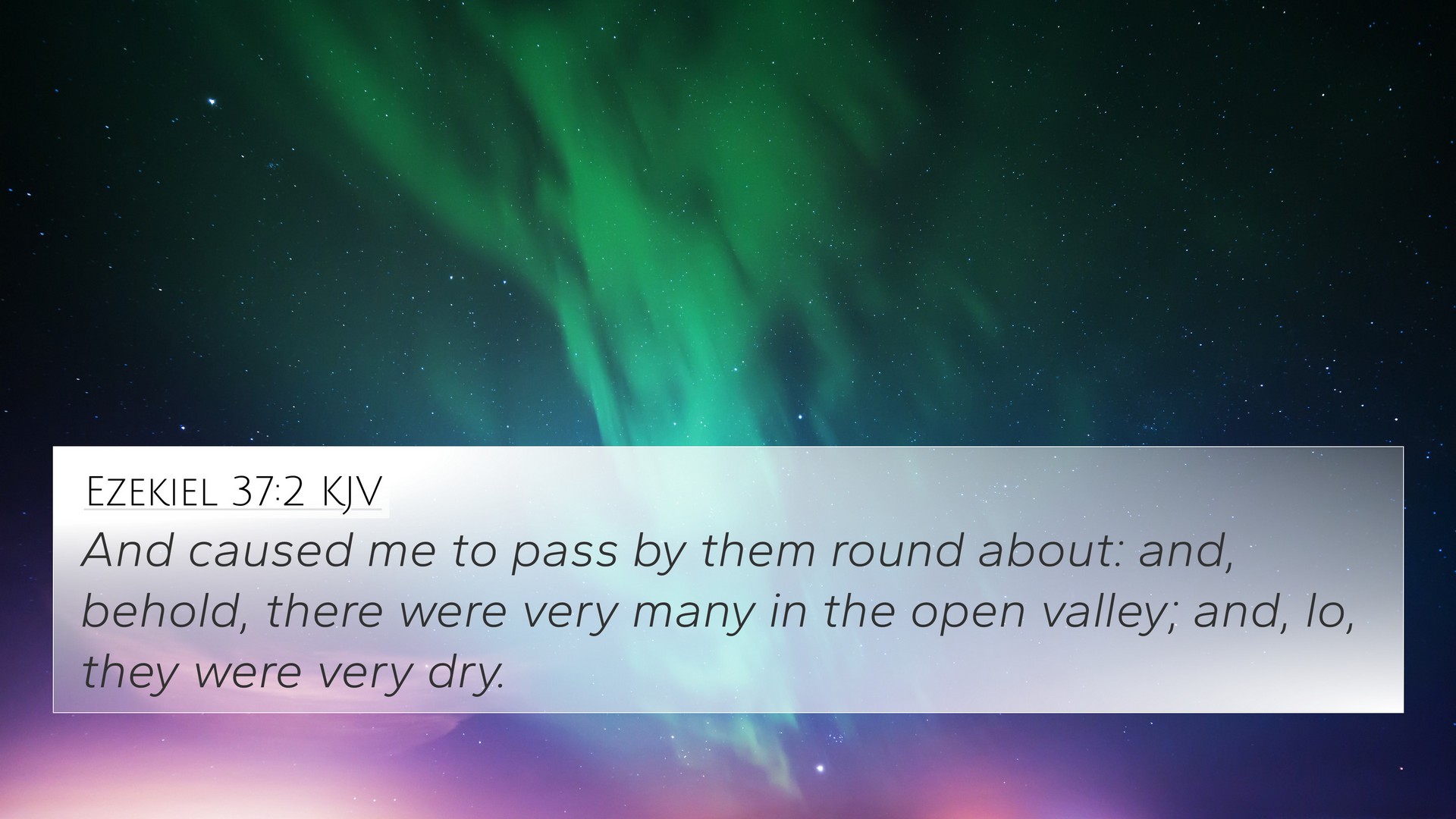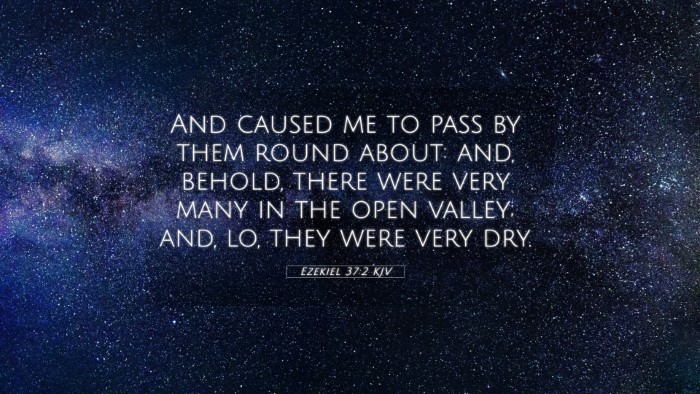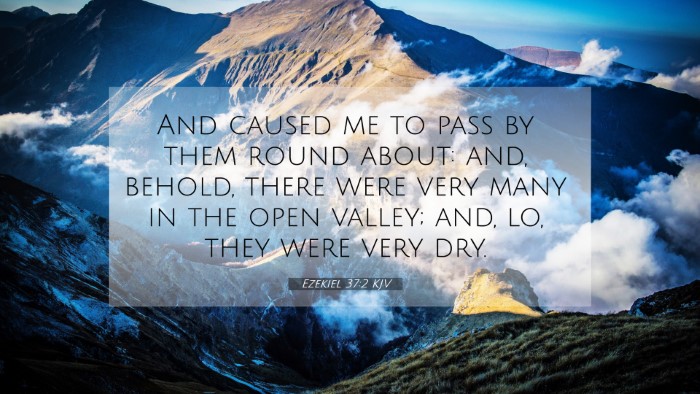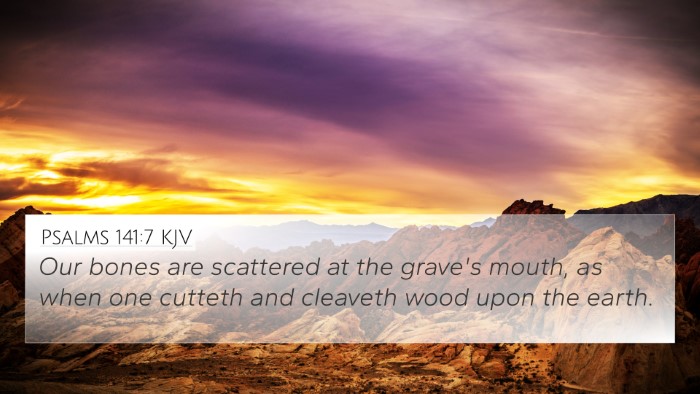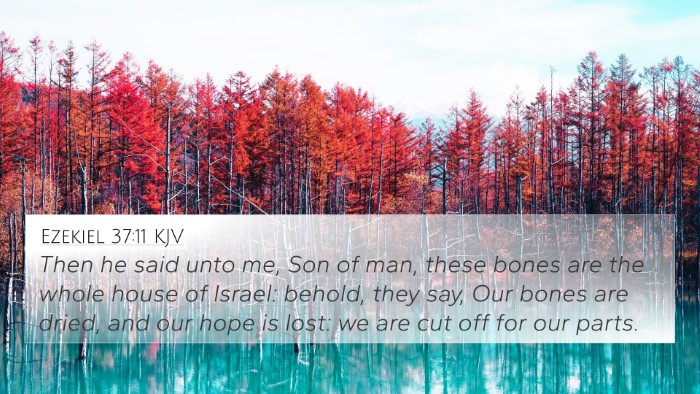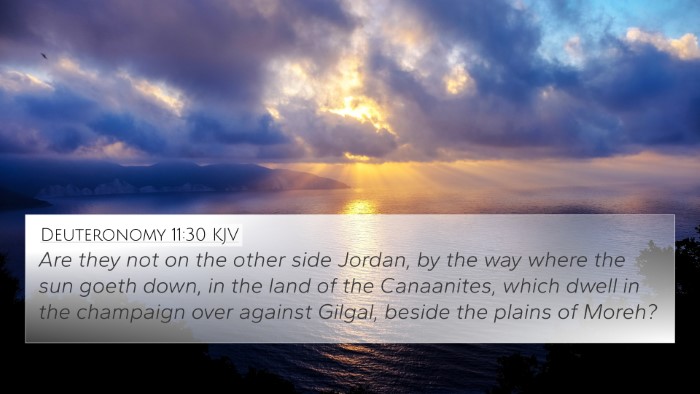Ezekiel 37:2 - Understanding the Valley of Dry Bones
Ezekiel 37:2 states: "And he led me round about through them; and, behold, there were very many in the open valley; and, lo, they were very dry."
This verse is pivotal in the vision of the valley of dry bones, where God shows Ezekiel the spiritual state of Israel. Here, we explore its meaning through insights from renowned public domain commentaries, connecting it with other scripture, and highlighting its relevance through thematic verse connections.
Commentary Insights
Matthew Henry's Commentary:
Henry notes the desolation depicted in the valley, which symbolizes Israel's spiritual death and hopelessness. The "dry bones" illustrate a nation that has lost its life and vitality. The Lord's inquiry to Ezekiel, asking if these bones can live, highlights the theme of hope and restoration that runs throughout the prophetic messages.
Albert Barnes' Notes:
Barnes elaborates on the imagery of "dry bones," discussing their state as signifying complete loss of life, representing the people of Israel in exile. The prophetic potential for revival signifies God's power to restore and renew His people, emphasizing His sovereignty in bringing about life where there appears to be none.
Adam Clarke's Commentary:
Clarke focuses on the symbolic implications, indicating that the vision of the dry bones is also a reflection on the moral and spiritual decay of the people. The dry bones signify a complete separation from God, and the subsequent restoration represents God's promise of redemption and renewal for Israel.
Related Bible Verses and Cross-References
Ezekiel 37:2 is connected to several other verses, enabling a deeper understanding of its message. Below are some verses that relate to the themes of dry bones, restoration, and spiritual revival:
- Ezekiel 36:26 - "A new heart also will I give you, and a new spirit will I put within you..." – emphasizes God's promise of transformation.
- Isaiah 26:19 - "Thy dead men shall live; together with my dead body shall they arise." – a prophetic statement on resurrection and hope.
- Romans 8:11 - "But if the Spirit of him that raised up Jesus from the dead dwell in you..." – connects the idea of spiritual resurrection through God’s Spirit.
- John 11:25-26 - "I am the resurrection and the life..." – demonstrating Christ's power over life and death.
- Revelation 21:4 - "And God shall wipe away all tears from their eyes..." – illustrating God's ultimate restoration of His people.
- 1 Peter 1:3 - "Blessed be the God and Father of our Lord Jesus Christ, which according to his abundant mercy hath begotten us again unto a lively hope..." – highlighting renewal in Christ.
- Hebrews 11:1 - "Now faith is the substance of things hoped for, the evidence of things not seen." – underscores the foundation of faith in restoration.
- Joel 2:28 - "And it shall come to pass afterward, that I will pour out my spirit upon all flesh..." – a call for revival through the outpouring of God's Spirit.
- Psalm 42:11 - “Why art thou cast down, O my soul? and why art thou disquieted within me?” – resonates with feelings of despair and a longing for spiritual renewal.
- 2 Corinthians 5:17 - "Therefore if any man be in Christ, he is a new creature: old things are passed away; behold, all things are become new." – reiterates the theme of transformation and new life.
Theological Themes and Connections
The themes in Ezekiel 37:2 resonate deeply within the context of redemption and renewal throughout the Bible. The valley of dry bones not only symbolizes Israel's spiritual condition but also serves as a prophetic metaphor for the future hope of resurrection, prevalent in both the Old and New Testaments.
Within the Old Testament, the themes of hope and restoration are further developed through the prophetic books, where God continuously promises to redeem His people. Notably, Isaiah and Joel offer prophetic insights that foreshadow the renewal referenced in Ezekiel’s vision.
In the New Testament, the fulfillment of these promises is encapsulated in the life and resurrection of Jesus Christ. His resurrection signifies the ultimate triumph over death, echoing the revival of the dry bones as a testament to God's dynamic ability to restore life.
Cross-Referencing Biblical Texts
Utilizing tools for cross-referencing biblical texts allows for comprehensive study and deeper insight into the interconnectedness of scripture. As we draw connections between Ezekiel 37:2 and its related verses, we can appreciate the profound narrative of hope, redemption, and divine restoration available through historical and prophetic contexts.
- Cross-reference Bible study provides a systematic way to explore the multi-layered meanings behind biblical texts, enhancing understanding and retention.
- Bible concordance can be utilized to find themes and keywords, linking scriptures that speak to similar messages of life and revival.
- Bible reference resources serve as valuable tools for identifying connections between Old and New Testament scripture, enriching the study experience.
- Bible cross-reference guide aids in locating verses that share the same themes, facilitating a deeper dive into the biblical narrative.
- Comprehensive Bible cross-reference materials create pathways for discovering inter-Biblical dialogue, enhancing our understanding of God’s overarching plan for humanity.
Conclusion
Ezekiel 37:2 invites readers into a sacred moment of realization regarding the hopelessness of an exiled Israel. Through the collaboration of public domain commentaries and hermeneutic explorations, we see a vibrant tapestry of hope interwoven with the desolation symbolized by the dry bones. This verse not only speaks of restoration for Israel but also reflects God’s eternal promise of renewal through Jesus Christ.
As we engage with this scripture and its related verses, we uncover a landscape rich with spiritual insights and transformative truths that resonate across time, encouraging us to seek divine restoration in our own lives through faith and understanding.
